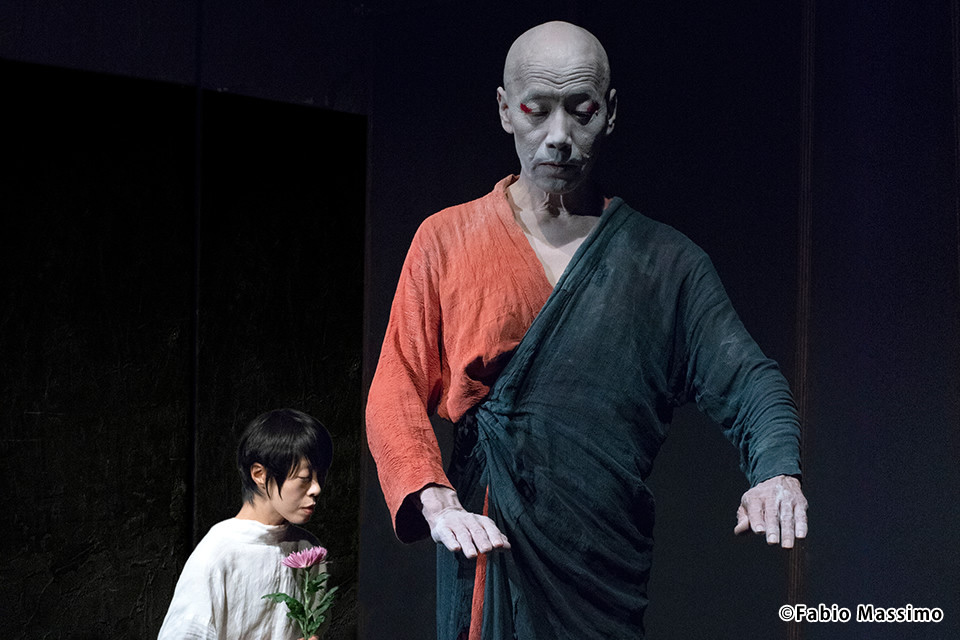上演作品 Feb 2017 -
KYOTO舞踏館上演作品 「 黄泉の花」
作・舞踏/由良部正美 ワキ/稲垣美輪子
私達は、太古から花に魅せられてきました。
祭礼や葬送、式典等、思いの深い場には常に花が添えられてきました。
その儚く散っていく命、つかの間の開花、つまりは儚い美の中に、私たちは時間を超えた世界を感じてきたのでしょう。
この時間を超えた世界を、日本では黄泉(よみ)という言葉で表してきました。
それは、黄泉がえり(甦り)の場でもあります。
死者も住むという黄泉の国は、どこか隔絶した世界にあるのではなく、最も身近にあります。
例えば、眠りの内に、また、言葉の奥に。
私達は、毎夜毎夜、眠りの中で黄泉の国に生き、そして、そこから新たな息吹と共に、帰ってきます。
私達のカラダとは、皮膚の中に孤立した島のようなものではなく、時間も超えた大海原と共にあるものではないでしょうか。
黄泉の息吹が咲かせる花なのではないでしょうか。
舞踏とは、このことの表現だと私は思っています。
カラダで何かを表現することではなく、このカラダ自身が、途方もなく奇跡の花なのだと感じていくことなのです。
観ているあなた自身のカラダとともに。
2017年春
由良部正美
Kyoto Butoh-kan Underworld Flower
Choreography and Butoh by Yurabe Masami
Additional Dance by Inagaki Miwako
This fleeting life, an ephemeral flower blossom—do we not discern a world beyond time in that transitory beauty?
This “beyond time” is expressed in Japanese by the word yomi, which refers to the world below. Yomi is a place of both return and resurrection.
This place where the dead dwell is not an isolated otherworld, but extremely near. For instance, during sleep or in the depths of words. Every single night asleep, we live in the world of yomi, then return home accompanied by new breath and vitality.
Rather than isolated islands, aren’t our bodies within a great ocean beyond time?
Is it not this new breath from yomi that causes flowers to bloom?
Butoh is for me an expression of this.
Not a presentation of something with our bodies—but to feel that the body itself becomes an outrageous miracle of a flower.
Along with your own body too, the viewer's...
Yurabe Masami
Spring 2017
出演
由良部正美
プロフィール:
1982年、舞踏グループ東方夜総会を退会後、ソロダンサー、振付家・演出家として活動を始める。
たくさんの舞踏作品、コラボレーション活動を発表。
2000年。ヨーロッパ最大ともいわれるリヨン・ビエンナーレ・ダンスフェスティバルのオープニングに招待されたのをはじめ、メルボルン・ダンスフェスティバル(2002年)、韓国のテジュンとテグでのダンスフェスティバル(2005年)、ポルトガルのSUL-Xダンスフェスティバル(2006年)等海外での招待公演も数多い。又、舞踏の黎明期を築いてきた笠井叡氏、大野慶人氏、詩人の河村悟氏を2005年、2006年と招き、「身体の裏側Ⅰ」「身体の裏側Ⅱ」を企画。古典の新芽シリーズでの文楽・義太夫との共演等、その活動は幅広い。又、長年舞踏クラスや、ワークショップを行いながら、他の身体技法との相対化の中で、新たな舞踏の血脈を探っている。2008年、京都西陣にて、自身の稽古場兼、フリースペースのスペースALS-Dをオープンし、日々のクラスの他、様々なダンスセッションなどを行っている。
2015年、2016年と、「舞踏という問い」という企画に参加し、舞台、ワークショップ等を通して、現代の舞踏の意味についてより若い世代と共に探る活動を継続中。
稲垣美輪子
プロフィール:
2013年より、由良部正美の下で学び、多くのダンスセッションに参加している。
The Performance
Yurabe Masami
Profile:
Yurabe Masami was a founder member of the seminal Butoh group Tōhōya-Sōkai. In 1982, he began working as a solo performer, dancer, and director. He has since worked on many dance pieces and collaborations. In 2000 he was invited to perform in France at the opening of the Biennale de la danse, said to be one of the biggest dance festivals in Europe. He has been invited numerous times to perform abroad, including the Melbourne Dance Festival (2002), Daejeon and Daegu Dance Festival in Korea (2005), and in 2006 to the SUL-X Dance Festival in Portugal. Concurrently for 2005 and 2006, he was invited by Butoh pioneers Akira Kasai and Ohno Yoshito, along with the poet Kawamura Satoru, to plan the workshop and performance series Reverse Side of the Body. He is active on many levels, such as collaborating with traditional Japanese Bunraku puppet theatre. Through many years leading workshops and classes, Yurabe Masami is pursuing new arteries of Butoh dance in the conjunction between techniques and differing perspectives of the body. In 2008 in west Kyoto, he opened his own open-air performance space, ALS-D. He holds daily classes and conducts various dance events.
As a producer of "The Question of Butoh" series in 2015 and 2016, he leads the next generation of dancers in finding meaning and value in Butoh for the contemporary era.
Inagaki Miwako
Profile:
Inagaki Miwako has been studying under Yurabe Masami since 2013, and is quite active in various dance events.


